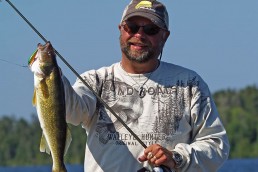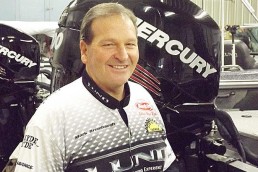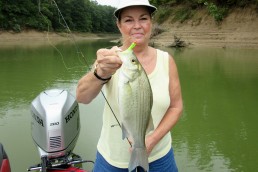Flowing Water ‘Eyes
SHARE THIS POST
Target walleyes in late summer with simple trolling tactics
Overlooked? Yep. Under-fished? You bet. Out of sight, out of mind? Oh yeah. I’m talking about walleyes that live in river systems all year long.
While spring is definitely the average angler’s go-to time when it comes to targeting walleyes in flowing water, especially with the millions of fish migrating from nearby lakes to spawn, savvy anglers will search out fish that stick around all year.
But truth be told, although they may not be as plentiful during the late summer, there are still more than enough resident fish to fill the livewell for those willing to take the time to target them. And the best way to go about getting an offering into the face of as many fish as possible is to cover as much water as you can.
Trolling is how I like to get this job done.
The best part of targeting river ‘eyes while trolling in summer is through employing a simple tactic.
Flow-trolling basics
Trolling both upstream and downstream will take fish, but going at just the right speed is the key to success.
Although the Lowrance sonars on both of my Lund’s dashes and bows are always on when I’m fishing rivers, I’m not concerned about my trolling speed being displayed on the screens. This is because the current speed is always changing “run to run” or “hole to hole” and I have to change up my tempo accordingly. Nevertheless, trolling with the correct momentum is crucial.
Instead of relying solely on GPS, I’ll discern whether or not I am going at a “good” pace by how my crankbaits are running within the current. This is why I always have my hand on the throttle of my kicker motor—I can adjust the RPMs and speed up or slow down depending on how my lure is waggling at the moment.
Luckily, Rapala lures run true and swim properly, even when trolling upstream in heavy current. Bump a few too many rocks however, and you may have to tune your lure back to its perfect, out-of-the-box wiggle. You can do this by bending the eyelet at the head of the lure just slightly with a pair of fisherman’s pliers. (Tip: Bend the eyelet in the opposite direction the lure rolls, but only slightly, and if you feel the eyelet move you have twisted it too far.)
Another problem with trolling over gravel- and rock-filled bottoms is that a lure’s hooks can become dull or damaged in a short time. I’m always testing the sharpness of my lure’s hooks by placing their points on my thumbnail and then trying to scrape them over it. If the hook slides easily, it needs to be sharpened; if it sticks, the hook’s sharp. To sharpen, I use a hook file to touch it up.
Are you enjoying this post?
You can be among the first to get the latest info on where to go, what to use and how to use it!
If a lure’s hooks have been severely damaged or been filed off too much from sharpening multiple times, I’ll replace them with Daiichi hooks of the same size. I use the same size hook because the lures may not have the same action with lighter or heavier hooks, thus fish may not strike.
In its place
Proper lure placement is a crucial piece of the walleye-catching puzzle in rivers, so the depth below me is something I am always watching on my units—even more so if the water’s stained and I can’t see the bottom. I always need to know whether my lure is in the middle of a deep run, along its edge or up on top of a shallow, silt-filled flat.
Overall, I want my lure to be running through the deepest part of a hole or run, yet right up tight to where it starts to rise up and get shallower. And it’s along the drop-offs where the majority of walleyes sit, awaiting food to drift their way.
Whether trolling with or against the current, I want to motor just fast enough so that my crankbaits, like the Shad Raps and Scatter Rap Shads, are wiggling perfectly. That is, not so fast that they spin out of control or not too slow so they don’t have any action at all.
When trolling upstream, it may feel as if you’re nearly sitting stationary with the lure swimming wildly nosed into the flow. The opposite holds true when trolling downstream, and you’ll have to motor faster than you might think to keep the lure wiggling. But not to worry, as river walleyes are used to nabbing forage as it swims downstream, and they will strike your fast-paced bait without hesitation.
Responsive rods and line are an important part of being able to “feel” if my lure is running correctly. I use a medium-action Fenwick rod and Abu Garcia reel spooled with 10-pound-test Berkley FireLine.
I also like using leadcore line in rivers, as I can get my lure down deep without having to let a lot of line out which helps in reducing snags. A medium-action Fenwick trolling rod and Abu Garcia line-counter reel filled with Suffix 832 Advanced leadcore is my preference. And I link the lure to the leadcore via a 6-foot leader of 10-pound-test Berkley 100% Fluorocarbon. To the tip of the fluorocarbon, I tie on a Berkley Cross-Lok Snap (not snap-swivel) to allow an easy “on and off” when changing lures, as well as allowing the bait its maximum action. Too much “hardware” and the lure’s action will be ruined.
When trolling with more than one rod at a time, I like to place all but the one I am hanging on to in rod holders. But just because the rod is cradled in the holder rather than my hand doesn’t mean I am not always adjusting the amount of line that’s out at all times. The reason for continually adjusting the length of line is that I want my Rapalas to be running “at” the bottom, and not “on” the bottom. The moment I see or feel the lure is bouncing on the bottom, I’ll reel in a few feet of line until the lure stops ramming into it. And if my sonar shows the water just got deeper, I’ll let out just enough line until the lure ticks the river’s floor and then reel in a couple feet to make sure it’s in the strike zone.
If you have a favorite river with walleyes in it, then by all means, cover the water by trolling. Crankbaits fished near the bottom are always a great choice. Just make sure your lures are running true and at the right pace.
Mark Martin is a professional walleye tournament angler and instructor with the Ice Fishing School/Vacation series. Check out his website at markmartins.net or fishingvacationschool.com for more information.
MWO
SHARE THIS POST
Did you enjoy this post?
You can be among the first to get the latest info on where to go, what to use and how to use it!
Mark Martin
Mark Martin is a professional walleye tournament angler and instructor with the Ice Fishing School/Vacation series. For more information, check out his website at markmartins.net or fishingvacationschool.com.



